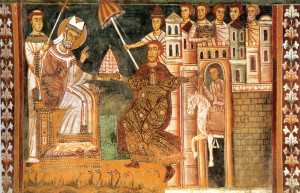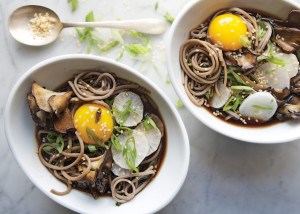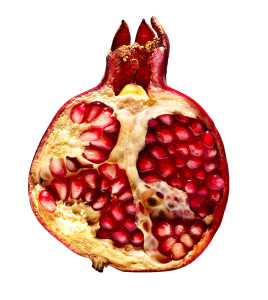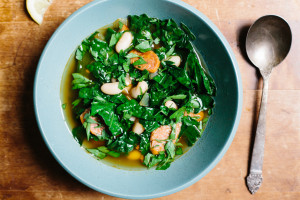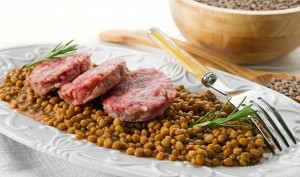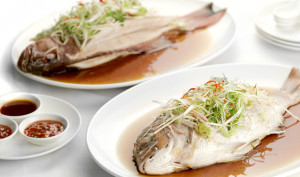New Year’s Eve is Saint Sylvester’s Night. If an east wind is blowing, it promises a calamitous next twelve months.
Roman-born Pope Sylvester I was pope from January 31, 314 to his death on December 31,,335. He is buried in Rome’s Catacombs of Priscilla.
During his pontificate, the great churches founded at Rome by Constantine: the Basilica of St. John Lateran, Santa Croce in Gerusalemme, Old St. Peter’s Basilica, and several cemeterial churches, were built over the graves of martyrs. Otherwise little is known about Sylvester’s life. The accounts preserved in the 7th-8th-century Liber Pontificalis contain little more than a record of the gifts Constantine gave to the Church during Sylvester’s reign.
According to Saints Preserve US!, one legend recounts that Pope Sylvester cured the Emperor Constantine of leprosy and baptized him; in return the grateful ruler made Christianity the Roman Empire’s State religion and gave the Bishop of Rome enormous temporal powers. Another tells that, when an ox dropped dead at a conclave of magicians, pagan priests, and rabbis organized by Constantine, Pope Sylvester restored the beast to life in Christ’s name so the Emperor and all his subjects converted to Christianity.
Similarly to Constantine’s legendary conversion, the night of St. Sylvester offers an opportunity to forget the past and make a clean start. Instead of leaving everything up to fate, why not enjoy a special meal to increase your next year’s good fortune? Traditions vary from culture to culture, but there are several internationally auspicious foods:
LONG NOODLES: In China, Japan, and most other Asian countries, it’s customary too eat long noodles on New Year’s Day. They signify longevity. Since they must never be broken or shortened during the cooking process, the typical preparation for “Long-Life Noodles” is to stir-fry. Chewing would also break them, so you must eat them by slurping.
GRAPES: Since 1909, when there was a surplus of grapes in the Alicante region, revelers in Spain consume 12 grapes as the clock chimes midnight. This tradition spread to Portugal and former colonies: Venezuela, Mexico, Ecuador, Brazil, and Peru, where they add a 13th grape for good measure. Each grape represents a different month, so if, for example, the third grape is sour, March might be a rocky month.
POMEGRANATE: In Greece and Turkey, when it turns midnight, pomegranates are thrown on the floor to smash. The more seeds the better because they symbolize prosperity and good fortune. Their red color represents the human heart, and denotes life and fertility.
COOKED GREENS: Cooked greens: cabbage, collards, kale, and chard, are eaten because they look like folded money so the more you eat the greater your fortune next year. The Danes sprinkle their kale with sugar and cinnamon.
LEGUMES: Like cooked greens legumes are symbolic of money, this time coins. In Italy, where they’ve been eaten since ancient Roman times, it’s customary to eat cotechino con lenticchie or lentils and sausages just after midnight. Lentils supposedly turn into gold coins. In Italy the best lentils come from Castelluccio, a small village in the Apennines near Norcia, where St. Benedict was born. Norcia is also famous for black truffles and sausages.
Germans and Hungarians also partner legumes with pork, usually lentil or split-pea soup with sausage; in Brazil it’s lentil soup or lentils with rice, and in Japan, osechi ryori, a group of symbolic dishes eaten during the first three days of the New Year includes sweet black beans.
In the Southern United States “Hoppin’ John”, a dish with black-eyed peas, has been the tradition since the Civil War. It’s said that, when the town of Vicksburg, Mississippi ran out of food under siege, the inhabitants survived thanks to black-eyed peas. Some people believe in eating one pea everyday during the whole New Year for good luck.
CORNBREAD: Although a favorite throughout the year, cornbread is especially venerated on New Year’s Eve in the southern United States because of its golden color. To ensure some extra luck, some people add extra corn kernels, to represent gold nuggets.
PORK: Pork is customarily eaten at New Year’s because pigs represent progress (the animal never moves backwards; it always pushes forward, rooting itself in the ground before moving in search of food.) and its fat signifies wealth and prosperity. Roast suckling pig is served in Cuba, Spain, Portugal, Hungary, and Austria, where they also decorate the table with miniature marzipan pigs. The Swedes enjoy pig’s feet; the Germans, Americans, and Italians roast pork. Italy’s region Emilia-Romagna is particularly famous for pork delicacies: prosciutto, salami, mortadella, cotecchino, and zamponi.
FISH: Because it could be preserved and transported very long distances, cod has been a popular feast food since the Middle Ages especially in Roman Catholic countries where the Church forbade red meat consumption on religious holidays. Today from Christmas to New Year’s the Danes eat boiled cod and the Italians, especially the Romans, baccalà or dry salted cod. On New Year’s Eve the Poles, Scandinavians, and Germans eat herring and carp and save a few fish scales in their wallets for good luck because fish scales resemble coins. The Japanese eat fish roe for fertility, shrimp for long life and dried sardines, once used as fertilizer, for a good rice harvest. In China it’s important for the fish to be served whole—with the head and the tail intact to ensure a good year from start to finish. Fish also travel in schools, which represent prosperity, and they swim forward, never backwards, which symbolizes progress.
CAKES: At New Year’s in Italy, Poland, Hungary, and The Netherlands, cakes are customarily round to signify the year coming full-circle. Instead, in Mexico and Greece round cakes are baked with surprises or coins inside.
WHAT NOT TO EAT: Lobsters move backwards, so could cause setbacks. Chickens also scratch backwards, which could cause regret or dwelling on the past. Another theory warns against eating any winged fowl because good luck could fly away. In China white is the color of death, so they avoid tofu, eggs, and white cheeses.
DON’T CLEAN YOUR PLATE: The Germans leave a little bit of each food on their plate past midnight on New Year’s Eve to guarantee a well-stocked pantry in the New Year. For the same reason in the Philippines it’s important to have food on the table at midnight.

